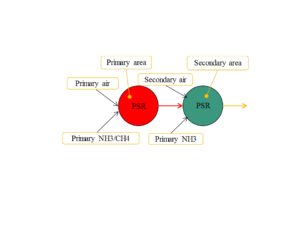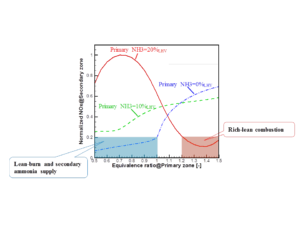Shogo Onishi1*, Shintaro Ito1, Masahiro Uchida1, Soichiro Kato1, Tsukasa Saito1, Toshiro Fujimori1, Hideaki Kobayashi2
[1] IHI Corporation, [2] Institute of Fluid Science, Tohoku University, Japan
NH3 Fuel Conference, Minneapolis, November 1, 2017
AIChE Annual Meeting, Topical Conference: NH3 Energy+
ABSTRACT
Ammonia is a carbon-free fuel, so it has potential to reduce carbon dioxide emission from power plants when used as a fuel. However, combustion characteristics of ammonia are notably different from hydrocarbon fuels, especially regarding NOx emission [1]. The nitrogen atom of the ammonia molecule may cause high NOx emission. Therefore, special techniques to reduce NOx emission are essential for gas turbine combustors which burn ammonia and natural gas. The results of our previous study [2] showed the characteristics of NOx emission in single-stage combustion. In this study, the concept for low-emission combustion in two-stage combustion has been examined numerically and experimentally.
Numerical study was conducted to investigate the combustion characteristics in two-stage combustion. A reactor network model comprising two perfectly stirred reactors (PSR) was calculated with CHEMKIN-PRO to evaluate NOx emission in short computation time. The reaction mechanism constructed by Tian et al. [3] was used. In the primary zone, methane/ammonia mixture is supplied as fuel. Then, only ammonia is supplied to the secondary zone (Fig.1). Air, methane and ammonia flow splits to primary and secondary zone are changed as parameters while total amounts of methane, ammonia and air flow rate are fixed. Figure 2 shows the numerical results in terms of NOx concentration in secondary zone against equivalence ratio in primary zone for three ammonia flow splits. These results revealed that there are two methods to achieve low NOx combustion, namely rich-lean combustion and combination of lean-burn and secondary ammonia supply. In the first method, NOx is produced only in the primary zone in fuel-rich condition and burned gas is diluted in the secondary zone with secondary air. Therefore, the NOx formation in the primary zone is dominant for emission. In the second method, lean combustion condition in the primary zone leads to low temperature and low oxygen concentration in the secondary zone. These conditions lead to low NOx concentration at the combustor outlet.These predicted combustion characteristics have been examined experimentally. Experimental results showed that NOx emission behavior is in good agreement with the numerical results.
Reference:
[1] M. T. Javed, N. Irfan, B.M. Gibbs, J. Environmental Management 83: pp. 251-289 (2007).
[2] S. Ito, S. Kato, T. Saito, T. Fujimori and H. Kobayashi, Proceedings of the Fifty-Third Japanese Combustion Symposium (in Japanese), (2015).
[3] Z. Tian, Y. Li and P. Glarborg, Combust. Flame 156: 1413-1426 (2009).
Read the abstract at the AIChE website.
DOWNLOAD
This presentation is not available to download.
RELATED NH3 FUEL CONFERENCE PAPERS
2016: Development of ammonia / natural gas dual fuel gas turbine combustor
2015: Combustion characteristics of ammonia / natural gas dual fuel burner for gas turbine combustor
LINKS
IHI Corporation
Institute of Fluid Science, Tohoku University
Learn more about the NH3 Fuel Conference 2017




Pingback: IHI Commits to Ammonia Energy. Big Time. – Ammonia Energy
Pingback: Performance of Ammonia-Natural Gas Co-Fired Gas Turbine for Power Generation | NH3 Fuel Association
Pingback: IHI Commits to Ammonia Energy. Big Time. - Ammonia Energy